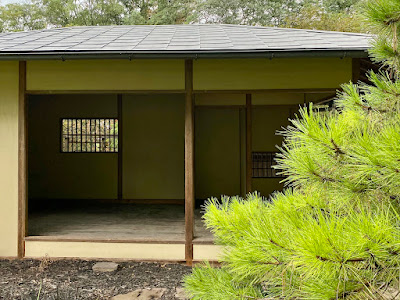The Garden of Serenity, located alongside the Bethlehem, Pennsylvania public library is a small Zen garden that was constructed in 1970 as part of a sister city relationship between the towns of Bethleham, PA and Tondabayashi, Japan that began in 1964.
Designed and built by Yoshinaga Sakon, the garden has many of he elements of an authentic Japanese garden. In fact, the materials for the garden and the teahouse where shipped from Japan and constructed on site. Cherry trees that were added in 1997 and 2014 help frame the backdrop of the garden. Starting in 2015 the Sister City Commission started an annual Bethlehem Cherry Blossom Festival which is widely attended by the local public.
The plantings surrounding the gravel beds, and stone bridges has grown considerably since it was first built in 1971. As a result, the garden appeared overgrown and in need of some maintenance.
 |
Below is an image of the garden from 2014 and before the removal of the pond and the addition of a new dog-eared fence.
The garden was clearly better maintained and the pond a significant feature of the garden.
The newly installed dog-eared picket fence now that surrounds the sides and front of the garden seemed out of place. I suspect the current fence was a cheaper money-saving alternative.
I would identify the pond removal and fence changes as the major criticisms of the garden. The pond's absence removes a necessary water feature while the fence looks stylistically odd. However, more importantly, the fence and locked gate near the teahouse prohibits visitors from entering the garden and experiencing it directly.
The fence essentially reduces the garden to a museum display and negates the purpose of a Japanese garden. The Itabashi Garden I recently visited in Burlington, ON, Canada, is similarly build adjacent to a public library, but it's design encourages visitors to view and walk through the garden.
I understand the need to protect the garden from uninformed visitors and the role the fence plays in this regard. However, I would advocate for either a more authentic fence, or the planting of shrubs and plants that could act as a natural "barrier" to define the garden perimeter. Perhaps a designated entrance and separate exit-way could allow visitors to enter, stay on a path, and move through towards the exit. Also, without question, the pond should be reestablished.
Correcting these mistakes would allow people to truly experience the joy of visiting a Japanese garden







